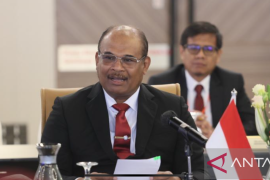"Some 780 sub-districts are located in the border regions. We will not be able to develop them simultaneously (as) everything increasingly depends on fiscal capacity, state financial capacity. Hence, based on the results of discussions with Bappenas (National Development Planning Agency), the funds that may be available are for 222 sub-districts," Karnavian noted here on Wednesday.
Development of the border sub-districts will be aligned with the regional potentials, but the reference remains for economic growth.
"They have economic potential there, be it fisheries, plantations, agriculture, or tourism. They could become a growth area that can stimulate other regions," he remarked.
Another objective of the development is developmental equality in various sectors to prevent any form of disparity in comparison with urban areas.
Moreover, development activities in borders are also in the interests of Indonesia's defense and security, particularly since the border is a frontier area that directly faces other countries.
Border areas that will be given priority in development include those in Anambas, Natuna, East Kalimantan, North Kalimantan, Papua and West Papua.
"A special team from ministries and institutions is already in place and working to oversee and evaluate the development to be implemented. We are upbeat that by the end of 2024, development in the 222 sub-districts will be complete, so the local people's welfare will be improved and the regions can become a buffer of the country's defense," he added. Related news: Development will ensure presence of state in outermost islands: President Jokowi
Related news: President`s Inpres to propel development of RI`s outermost islands: Minister
EDITED BY INE
Translator: Boyke LW, Fardah
Editor: Suharto
Copyright © ANTARA 2020












